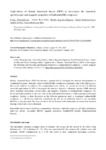Applications of density functional theory (DFT) to investigate the structural, spectroscopic and magnetic properties of lanthanide(III) complexes

Use este enlace para citar
http://hdl.handle.net/2183/25294Coleccións
- GI-REACT! - Artigos [113]
Metadatos
Mostrar o rexistro completo do ítemTítulo
Applications of density functional theory (DFT) to investigate the structural, spectroscopic and magnetic properties of lanthanide(III) complexesAutor(es)
Data
2011Cita bibliográfica
Carlos Platas-Iglesias, Adrian Roca-Sabio, Martin Regueiro-Figueroa, David Esteban-Gomez, Andres de Blas and Teresa Rodriguez-Blas, “Applications of Density Functional Theory (DFT) to Investigate the Structural, Spectroscopic and Magnetic Properties of Lanthanide(III) Complexes”, Current Inorganic Chemistry (Discontinued) (2011) 1: 91. https://doi.org/10.2174/1877944111101010091.
Resumo
[Abstract] Density functional theory (DFT) has become a general tool to investigate the structure and properties of complicated inorganic molecules, such as lanthanide(III) coordination compounds, due to the high accuracy that can be achieved at relatively low computational cost. Herein, we present an overview of different successful applications of DFT to investigate the structure, dynamics, vibrational spectra, NMR chemical shifts, hyperfine interactions, excited states, and magnetic properties of lanthanide(III) complexes. We devote particular attention to our own work on the conformational analysis of LnIII-polyaminocarboxylate complexes. Besides, a short discussion on the different approaches used to investigate lanthanide(III) complexes, i. e. all-electron relativistic calculations and the use of relativistic effective core potentials (RECPs), is also presented. The issue of whether the 4f electrons of the lanthanides are involved in chemical bonding or not is also shortly discussed.
Palabras chave
Density functional theory
Computational chemistry
Lanthanide complexes
Ab initio calculations
Relativistic effects
Rare earths
RECPs
Magnetic anisotropy
Sparkle/PM3 models
Hohenberg-Kohn theorem
Computational chemistry
Lanthanide complexes
Ab initio calculations
Relativistic effects
Rare earths
RECPs
Magnetic anisotropy
Sparkle/PM3 models
Hohenberg-Kohn theorem
Versión do editor
Dereitos
The published manuscript is available at EurekaSelect via http://www.eurekaselect.com/openurl/content.php?genre=article&doi=10.2174/1877944111101010091.
ISSN
1877-945X





